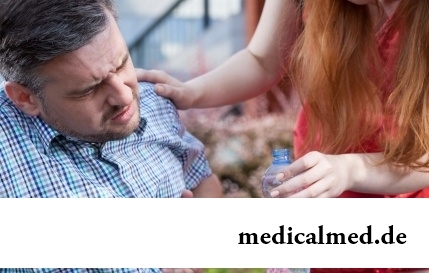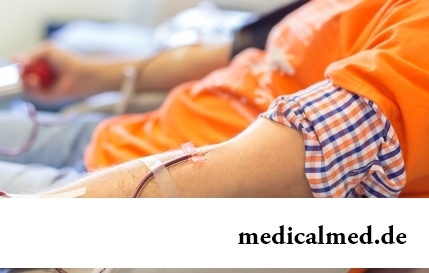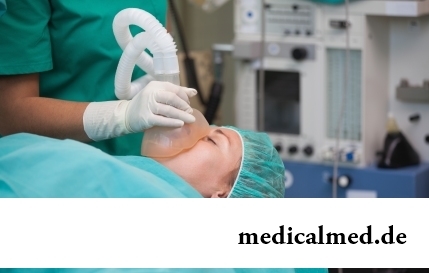





Anaphylaxis
The anaphylaxis represents acute and life-threatening reaction on a certain allergen which is followed by severe pain, hypostases, spasms of muscles and suffocation. Reaction can appear both after a sting of insects, and after drug intake or interaction with other allergens.
Reasons and symptoms of an anaphylaxis
Symptoms of an anaphylaxis can be shown at once or in several hours after allergic contact. The most often common symptoms of an anaphylaxis are hypostases, severe pain, a spasm of muscles, reddenings, skin rash, an itch, nausea, vomiting, hypostases of bodies of respiratory system.
Late symptoms of a disease are bronchospasms, hoarseness and the complicated breath, a hypoxia, urticaria, tachycardia. Heart begins to work spasmodically with interruptions and the wrong reduction. If not to give to the patient help, then the anaphylaxis leads to sharp falling of arterial pressure, a loss of consciousness and a lethal outcome.
A certain allergen as which medicines and their components, poison of insects, hair of animals, pollen of plants, foodstuff, etc. can act is the main reason for an anaphylaxis. Sometimes at the first contact with allergen the anaphylaxis is not shown, but at repeated interaction develops quickly enough.
The allergy and anaphylaxis influence at each other from availability of allergen. The anaphylaxis can be shown at hit of allergen in blood of the person and the introduction in reaction with immunoglobulin from which allocation of a histamine and formation of inflammatory process results.
Narcotic drugs and the contrasting substances, aspirin and nonsteroid drugs which cause anaphylactoid reactions in people with chronic diseases can be the reasons of an anaphylaxis. The allergy and an anaphylaxis are closely connected as patients with allergic reactions are often subject to an acute anaphylaxis.
Main types of an anaphylaxis
The anaphylaxis has several types, depending on a type of allergen. The disease can be divided into several categories:
- feeding response;
- reaction to anesthesia during operation and at rehabilitation;
- idiopathic reaction;
- medicinal, narcotic and nonsteroid reaction;
- reaction to exercise stresses;
- reaction to flora and fauna.
At manifestation of symptoms of an anaphylaxis it is necessary to define immediately type of allergen and to begin treatment. After the postponed acute anaphylaxis the patient within several years is exposed to risk of repeated reaction.
Treatment of an anaphylaxis
Treatment of an anaphylaxis is performed in the emergency order and consists in introduction of a certain dose of adrenaline. To patients who have chronic allergic reactions and transferred an acute anaphylaxis, it is necessary to carry with itself the syringe with adrenaline.
At ongoing symptoms of a disease urgent hospitalization of the patient and carrying out an intensive care is necessary. The patient has to be under constant observation of medical specialists before stabilization of a physical state.
After an anaphylaxis the doctor carries out observation of functioning of cardiovascular system, a brain, respiratory system and digestive organs. To the patient regularly measure the arterial pressure and pulse, and also appoint full diagnostic inspection.
For prevention of repeated display of an anaphylaxis appoint an immunotherapy which is intended for regulation of influence of allergens and preventing to development of inflammatory processes.
The liver is the heaviest body in our body. Its average weight makes 1,5 kg.

Not everyone can brag of the shining Hollywood smile. Even at the person who is regularly visiting the stomatologist and watching з...
Section: Articles about health
The modern person not always manages to find housing in the environmentally friendly region and such work which would not do harm to health. With food stuffs at first sight the situation is much better: shops are overflowed with goods which are positioned пр...
Section: Articles about health
Each woman has preferences in the field of use of those goods which help us to look good, feel young and effective. Besides: selection process of favourite perfume, shampoo or decorative cosmetics already lightens the mood and serves as a peculiar stress medicine. Happens very offensively when the acquired perfumery and cosmetic products not only do not meet our expectations, but also becomes the reason of problems with health. Sources неприятн...
Section: Articles about health
Statistically cystitis 25-30% of women up to 40 years have. With age this indicator raises, besides many do not get in to become...
Section: Articles about health
It is pleasant to state a possibility of improvement of quality of life of people with problems of functioning of secretory system. Efforts of talented inventors created products which will be able to provide normal life activity of clients with moderate degree for...
Section: Articles about health
Each of us repeatedly noticed that the people having the same passport age are sometimes not similar on one-years at all. One at the age of 40-45 years already looks almost an old man, and another and in 60 is young, vigorous and full of life. The matter is that the condition of our health depends not on the number of the lived years, and on degree of safety of an organism. This factor also defines biological age of the person....
Section: Articles about health
The phenomenon of improvement of a condition of the patients at administration of drugs who are not containing active agents, so-called effect of placebo is known...
Section: Articles about health
"Epilepsy" doctors made the diagnosis in antique times. Displays of an illness and pattern of its development are very well studied. However for nonspecialists this disease remains to not less mysterious, than in the ancient time. Many delusions are connected with epilepsy...
Section: Articles about health
The body of the person almost for 60% consists of water. It is so important for normal functioning of an organism that loss of only one and a half percent of liquid already leads to the most unpleasant effects. The problems connected with deficit of water can overtake also the healthiest person if he, for example, spends several hours under the scorching sun, without having taken with themselves drink, but is very simple to correct health in this case. It is much more difficult to minimize effects of other reasons about...
Section: Articles about health
About 20% of the population of our planet have a hypertension (permanent increase in arterial pressure). This disease negatively narrations...
Section: Articles about health
For most of the working people the problem of having a snack is particularly acute enough. Sooner or later there is a question: what can be eaten quickly between a breakfast and a lunch or a lunch and leaving from service so that to receive necessary power feed, but not an overload...
Section: Articles about health
Statistically, at the address to doctors seven of each ten patients complain of a headache. Actually it is much more people who are periodically feeling unpleasant feelings such. Many people, apart from a headache the reason for serious fears, prefer to muffle independently the next attack medicines. Such behavior is extremely careless, especially if this symptom appears regularly and is followed by other signs of an indisposition. Constants head Bol...
Section: Articles about health
Zone hypostases under eyes - very widespread problem giving to people is a lot of inconvenience. Hypodermic fabric in these parts having...
Section: Articles about health
History of cultivation of a buckwheat contains more than five thousand years. Grain which is received from this plant is used for preparation of porridges, soups, baked puddings and puddings, do flour which is one of the main ingredients of the noodles popular in of it...
Section: Articles about health
It is possible to find the extensive range of fruit and vegetables in modern shops. Russians already got used that on counters there is not only a seasonal domestic production, but the vegetables and fruit which are grown up in the countries with more comfortable conditions of cultivation at all seasons of the year. However what we see in shops and in the vegetable markets, is only a small part of those edible plants with which the nature is so rich. Today we want to acquaint the reader with rare and very useful vegetables which on...
Section: Articles about health
To look healthy and means well-groomed not only to be pleasant to people around, but also to feel strong, sure and taken place. To Spa...
Section: Articles about health
Each of us faces from time to time that other people need the immediate help. We react to it differently: one at once call doctors and police, others rush to victims and try to save them independently. Some at all...
Section: Articles about health
Transfusion of donor blood has almost century history. In spite of the fact that this procedure is quite usual for many people, process of blood donation is still surrounded with numerous myths. Today we aimed to discredit the most widespread of them....
Section: Articles about health
The number of long-livers is very small. One person from 5 thousand lives up to age of 90 years, and the centenary boundary steps only about...
Section: Articles about health
When overcomes feeling of hunger, and an opportunity to have dinner fully is absent, having a snack − the meals, small on volume, stabilizing sugar level in blood comes to the rescue. The relation of nutritionists to having a snack is more often negative, but only because in кач...
Section: Articles about health
According to data of World Health Organization, the cataract is diagnosed almost for 7% of the population of Earth. The statistics of incidence is considered not full as at an initial stage the illness, as a rule, does not cause to the person of special inconveniences, and many diseased sees doctors not at once. The cataract is not only one of the most widespread ophthalmologic illnesses, but also the reason of a half of cases of loss of sight....
Section: Articles about health
History of use of an anesthesia during operations contains more than 160 years. Annually in the world hundreds of thousands surgical вм are carried out...
Section: Articles about health
Season of activity of viral infections in the heat. Everyone can get sick, but probability of this unpleasant event it is possible and it is necessary to minimize. There is a number of rules, following to which will help or to avoid absolutely infection with flu or a SARS, or to have an illness...
Section: Articles about health
The nature does not stand stagnation and monotony. It is known that tissues of a human body atrophy if do not receive necessary loadings. It fully belongs also to a cerebral cortex: when it is not given full-time job, it begins to function worse. As a result memory decreases, the person becomes less bright, acquires information more slowly, hardly switches from one thought to another. There are problems at work, difficulties with communication and career development. These it is unpleasant...
Section: Articles about health
The business lady, the become mother, it is necessary to solve an array of problems. But of them is main: how to combine the beloved child and work?...
Section: Slideshow
Kidneys perform the most important function of clarification of blood from those products of metabolic processes which cannot be used by an organism for obtaining energy and construction of new cells. With the urine produced by kidneys from a body of the person bulk is removed...
Section: Articles about health
Life does not indulge the modern woman special emotional comfort and carelessness. The fatigue, troubles at work, misunderstanding in a family and various illnesses immediately affect a condition of hair and skin. And there is a wish to look safe and attractive so! Substantially competently picked up diet can improve situation....
Section: Articles about health
